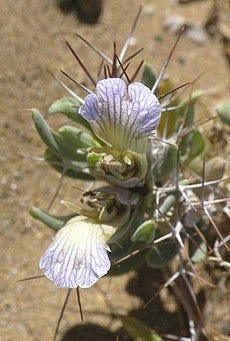Genus Blepharis Blepharis mitrata plant

No! Then let’s start the discussion about Blepharis mitrata.
Blepharis mitrata is a plant found in rocky areas of Namibia (a Country in Southern Africa). This plant does not grow in the dunes. The whole plant is spiny with elliptical-shaped leaves. It is a species of plant in the family Acanthaceae( the acanthus family). Other species of the Blepharis genus are B.grossa and B.pruinosa. Blepharis mitrata plants have medicinal properties to help cure hemorrhoids, Fontanel hardening, cough, and wounds.
Taxonomic details
Kingdom- Plantae
Subkingdom- Viridaeplantae
Phylum- Tracheophyta
Subphylum-Euphyllophytina
Infraphylum-Radiatopses
Class-Magnoliopsida
Subclass-Lamiidae
Superorder -Lamianae
Order-Scrophulariales
Family -Acanthaceae
Genus-Blepharis
List of Plants of Genus Blepharis
- Blepharis attenuata Napper
- Blepharis ciliaris
- Blepharis crinita Juss
- Blepharis dhofarensis,A.G.Mill. (es;pt)
- Blepharis edulis
- Blepharis linariifolia Pers
- Blepharis maderaspatensis (L.) B. Heyne ex Roth
- Blepharis mitrata C.B.Clarke
- Blepharis sindica
- Blepharis spiculifolia BAlf.f
Therapeutic uses of Blepharis mitrata
- Help to cure hemorrhoids ( i.e. Swollen and inflamed veins in the rectum and anus that cause discomfort and bleeding).
- Blepharis mitrata have medicinal properties to help to cure Fontanel hardening ( i.e. Fontanel means the soft spot is an anatomical feature of the infant human skull comprising quiet membranous gaps between the cranial bones that make up the calvaria of a fetus ).
- It helps to cure coughs and wounds.
References:
en.m.wikipedia.org
https://commons.wikimedia.org/wiki/Category:Blepharis_mitrata
ncbi.nlm.nih.gov
researchgate.net
scholar. google.co.in
S.Vijayalakshmi and K.G.Kirpa (2016), “ Therapeutic uses of plants of genus Blepharis- A systematic review”. Department of Biochemistry, school of life science, Vels University, Chennai -600117.Int J Pharma Bio Sci;7(4): (B) 236–243.
Comments
Post a Comment
Please do not enter any spam link in the comment box.